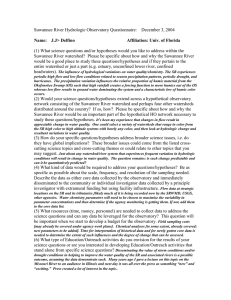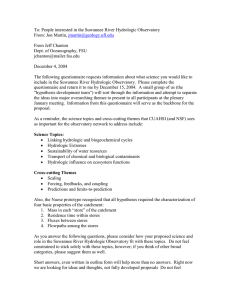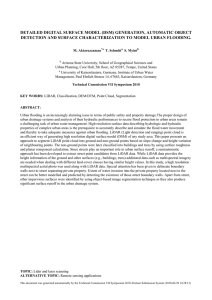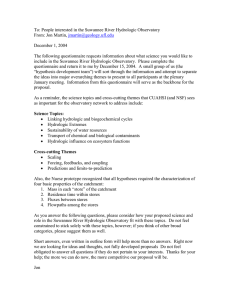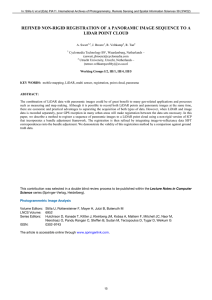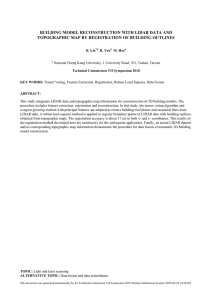Slatton
advertisement
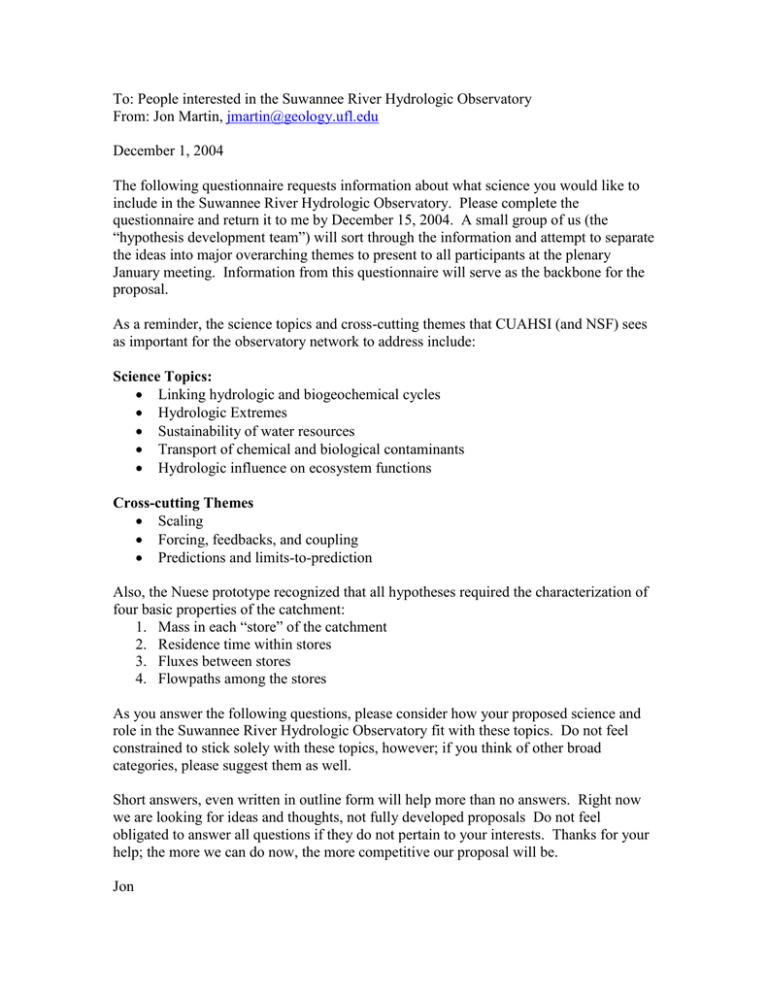
To: People interested in the Suwannee River Hydrologic Observatory From: Jon Martin, jmartin@geology.ufl.edu December 1, 2004 The following questionnaire requests information about what science you would like to include in the Suwannee River Hydrologic Observatory. Please complete the questionnaire and return it to me by December 15, 2004. A small group of us (the “hypothesis development team”) will sort through the information and attempt to separate the ideas into major overarching themes to present to all participants at the plenary January meeting. Information from this questionnaire will serve as the backbone for the proposal. As a reminder, the science topics and cross-cutting themes that CUAHSI (and NSF) sees as important for the observatory network to address include: Science Topics: Linking hydrologic and biogeochemical cycles Hydrologic Extremes Sustainability of water resources Transport of chemical and biological contaminants Hydrologic influence on ecosystem functions Cross-cutting Themes Scaling Forcing, feedbacks, and coupling Predictions and limits-to-prediction Also, the Nuese prototype recognized that all hypotheses required the characterization of four basic properties of the catchment: 1. Mass in each “store” of the catchment 2. Residence time within stores 3. Fluxes between stores 4. Flowpaths among the stores As you answer the following questions, please consider how your proposed science and role in the Suwannee River Hydrologic Observatory fit with these topics. Do not feel constrained to stick solely with these topics, however; if you think of other broad categories, please suggest them as well. Short answers, even written in outline form will help more than no answers. Right now we are looking for ideas and thoughts, not fully developed proposals Do not feel obligated to answer all questions if they do not pertain to your interests. Thanks for your help; the more we can do now, the more competitive our proposal will be. Jon Suwannee River Hydrologic Observatory Questionnaire: December 3, 2004 Name: Clint Slatton Affiliation: UF, Department of Electrical & Computer Engineering (ECE) and also Department of Civil & Coastal Engineering (CCE) (1) What science questions and/or hypotheses would you like to address within the Suwannee River watershed? Please be specific about how and why the Suwannee River would be a good place to study these questions/hypotheses and if they pertain to the entire watershed or just a part (e.g. estuary, unconfined lower river, confined headwaters). Background 1: I am an EE, not a hydrologist. So my interests are guided by notions of spatially distributed stochastic processes, and our ability to observe and model them. I am also interested in applying machine learning concepts to make estimators that adapt in scale and according to land cover. However, I am a layman when it comes to knowing which parameters are most critical for hydrology. Background 2: Since the Cuashi HOs, such as the Suwannee, are rather large, it may not be appropriate to think in terms of mapping the entire site with the UF lidar. It could be done, but large scale mapping just for the sake of having a map is viewed as the purview of private industry lidar providers. The private companies belong to a congressional lobbying group known as MAPS that has complained vigorously in the past when universities try to map large areas without very clear research plans for the data itself. This is something that we should discuss at some point with the NSF/Cuashi “upper management”. However, please discuss with me, Ramesh Shrestha, and Bill Carter first. Ramesh and Bill have a lot of perspective on this issue. Limited lidar coverage by UF is no problem at all. If the HO wants complete coverage, it may still be fine for a single HO. It will probably not be fine if proposed for every HO. Another point on the topic of getting lidar data from industry versus academia is that, as academic providers, everything we do is open source. The raw data can be made available so that individual PIs can compute improved elevation models as time goes by. We also have a deeper understanding of the lidar data phenomenology and can work with PIs using the data. With all of that said, I (for my own research) would like to study (1) new ways to estimate fine-scale surface features under dense forest canopies using lidar and (2) connections between precipitation interception by canopy and surface runoff to local canopy structure. As you may already know, the UF lidar system can quantify the 3D landcover structure and terrain elevations at high spatial resolutions (15 cm rms vertically and 25 cm rms horizontally) with data densities of ~2 shots per square meter (higher densities are easily obtained with more passes). Yet the density of low and mid canopy observations from any such lidar system will vary with terrain slope and canopy structure. I would like to collect UF lidar data over small subsets of the HO multiple times to better parameterize this. For example, if we had some selected sites with good rain gauge and LAI time data loggers and runoff/stream data, we could fly the UF lidar before and after heavy rain events and in different seasons and derive spatially heterogeneous relationships among these parameters and forest gaps, forest edges, and different types of forest. At this year’s AGU Fall meeting it was clear that lidar has been recently embraced by the surface-geomorphology community, but it has much untapped potential in the hydrologic community too. (2) Would your science questions/hypotheses extend across a hypothetical observatory network consisting of the Suwannee River watershed and perhaps four other watersheds distributed around the country? If so, how? Please be specific about how and why the Suwannee River would be an important part of the hypothetical HO network necessary to study these questions/hypotheses. It could be applicable in many watersheds, but the Suwannee is particularly well suited because we have such tall, dense forests here in FL. We generally have thicker understory growth than higher-latitude or drier watersheds I think. If we can demonstrate improvements in fine-scale surface topographic estimation through FL forests, it will be doable in most other places. The end result would be to increase the number of areas to which detailed runoff models can be applied. I also work with multiscale fusion of different data sets (e.g. lidar, sonar, radar). So we could study the scaling relationships of the Suwannee. How much lidar data and at what resolution do you really need to quantify runoff? We could address such issues. The answer depends on the precision your hydrologic models require and which parameters are required. We can work to estimate those parameters at different scales and measure (mathematically) the corresponding uncertainties. This is what must guide the question of scaling. I work routinely with multiscale estimation and my students and I can measure the uncertainty at each node (pixel). But if we worked with hydro folks, we could set acceptable limits on global and local uncertainty to derive principled solutions to scaling questions. (3) How do your specific questions/hypotheses address broader science issues, i.e. do they have global implications? These broader issues could come from the listed crosscutting science topics and cross-cutting themes or could relate to other topics that you may suggest. I believe so, but I need help from the hydro (science) people on this. I don’t know the critical questions to ask from a science perspective. (4) What kind of data would be required to address your questions/hypotheses? Be as specific as possible about the scale, frequency, and resolution of the sampling needed. Describe the data as either core data collected by the observatory and immediately disseminated to the community or individual investigator data collected by a principle investigator with extramural funding but using facility infrastructure. What we refer to as “research grade” lidar data is the key component. This is distinct from industry-provided “products”. We rigorously calibrate our system and use processing and GPS ground truth to ensure we have the best data we can get. We also have a ground-based laser scanner for under-canopy sensing and digital multispectral aerial camera. However, this means little for hydro unless it is coupled with in situ measurements of things like LAI, rain fall, and runoff. Also, it must be acquired over selected sites many times to obtain temporal variation rather than “snapshots” in time. (5) What resources (time, money, personnel) are needed to collect data to address the science questions and can any data be leveraged for the observatory? This question will be important when we start to develop a budget for the observatory. I can’t speak to the in situ measurements. For lidar, we will want to image selected sites multiple times a year to capture seasonal and storm responses. If the areas are small (e.g. 4 km ^2) and within a ½ day drive of UF, lidar fields costs will be very low. Costs will scale both with distance from UF and with imaged area. The sites could be selected based on where the hydro folks want to put their in situ instruments. We should have a one-time overall map of much of the catchment as well. (6) What type of Education/Outreach activities do you envision for the results of your science questions or are you interested in developing Education/Outreach activities that stand alone from specific science questions? Ramesh, Bill Carter, and I are part of the NSF center called NCALM. See www.ncalm.ufl.edu. We already have a Web site hosted by our partner (Berkeley) for disseminating data and data tools. We can tie that it in with the HO. We have also recently developed a multidisciplinary geosensing graduate program, hosted in the CCE Department. Through NCALM we will offer small seed grants to grad students. (7) If you do not have specific science-driven topics, but wish to be involved in the observatory, please explain what your interests are and how you might interact with the observatory. My interests are sensing and modeling of distributed stochastic processes. I like remote sensing applications in general and radar and lidar applications in particular. I like to apply machine-learning and multiscale estimation to these interesting problems.
